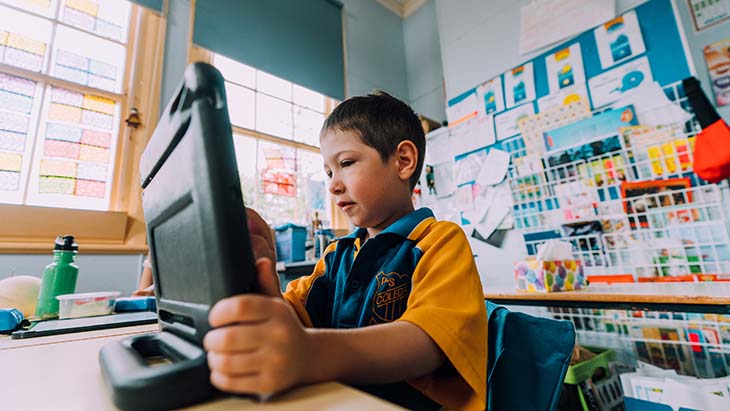Liam's story
Liam is a confident Year 3 student who loves sports (particularly basketball), technology and maths. He finds it very hard to concentrate and pay attention in class. Liam often doesn’t follow instructions, even when his teacher speaks to him directly, and rarely completes homework or learning tasks on time. Liam is easily distracted by other students and gets out of his seat a lot to see what’s happening. He talks frequently in class (often off-topic), and taps his fingers on the table during quiet class activities.
Liam was diagnosed with Attention-Deficit/Hyperactivity Disorder (ADHD) last year. He is not currently on medication and sees a psychologist once a fortnight. Liam likes seeing the psychologist because the sessions are fun and engaging, and his psychologist gives him and his teacher ideas about things to do in class that help.

1. What are Liam's strengths and what has been helpful so far?
Liam's strengths:
- Liam is confident in some subjects, including sports and technology.
- Liam is very good at maths.
- Liam has a very supportive mum.
- Liam has access to a psychologist and enjoys the sessions.
- Liam loves solving Rubix and speed cubes.
What has been helpful:
- Sitting Liam close to his teacher at the front of the class has helped him listen and follow instructions.
- Getting Liam to work in pairs or small groups with others who share a similar interest and ability.
- Breaking a large task into small tasks.
What has not been helpful:
- Working in large groups has made it difficult for Liam to pay attention, stay on task and stay seated.
- Noise in and outside the classroom disrupts Liam’s concentration.
- Correcting Liam in-front of the class makes him uncomfortable.
2. What is the goal and why is it important?
The goal:
The overall goal is for Liam to complete activities in realistic time frames allocated by his teacher. Given Liam is proficient and motivated in mathematics, and therefore more likely to experience success, the initial goals are for Liam to work on a complex maths task that is broken down into small tasks and self-monitor his progress.
To monitor achievement of these goals, Liam’s teacher will get Liam to use the self-monitoring form. These goals may be developed into growth goals as part of the collaborative curriculum planning process and included in Liam's Personalised Learning and Support Plan.
Why:
Teaching Liam strategies to complete activities on time and self-monitor his progress is important for many areas of life, both currently, and for Liam’s future independence, confidence and workforce participation.
Personalised learning and support will ensure Liam enjoys a rigorous and meaningful education.
3. What evidence-based strategies can be used to reach the goal?
Strengths
- Sitting Liam close to his teacher at the front of the class has helped him listen and follow instructions.
- Working in pairs or small groups with others who share a similar interest and ability.
- Liam is confident in some subjects, including sports and technology.
Strategy
- Liam will continue being seated at the front of class, as far away as possible from outdoor noise and distractions.
- Liam will be seated with peers who share his interest in sports and technology.
- Liam’s teacher will get Liam’s attention through making eye contact and using his name before giving instructions.
__________________________________________________________________________________________________________________________
Strengths
- Liam is very good at maths.
- Breaking a large task into small tasks has been helpful.
- Liam loves solving Rubix and speed cubes.
Strategy
- A complex - yet achievable - maths task will be set and broken down to multiple small tasks. A realistic time frame for each task will be established.
- To manage the demands that tasks can place on Liam’s attention and concentration levels, simpler tasks will be introduced at the beginning and end.
- Visual support, such as displaying the list of small tasks in sequence, with a list of instructions on the white board will be used.
- A self-monitoring form will be printed and completed with Liam to keep track of his progress and timekeeping across tasks.
- Liam will be given a short break and permission to use his Rubix and speed cubes in between tasks.
__________________________________________________________________________________________________________________________
Strengths
- Liam has a supportive mum.
- Liam has access to a psychologist and enjoys the sessions.
Strategy
- Liam’s teacher will use a weekly email to communicate with Liam’s mum and psychologist to share and monitor how Liam is going with his goals, and to encourage - when relevant - the use of the self-monitoring form at home and in sessions.
School Excellence Framework alignment
Wellbeing, Effective classroom practice
Australian Professional Standards for Teachers alignment
Standard 1: Know students and how they learn
Audience
Primary teachers, SLSOs
Purpose
This resource explores Liam's experience in the classroom. Liam is a primary student who has a diagnosis ADHD. The example of practice features some of the strategies that have support Liam at school.
Reviewed
November 2021. Share your feedback here
Explore other topics
1/4